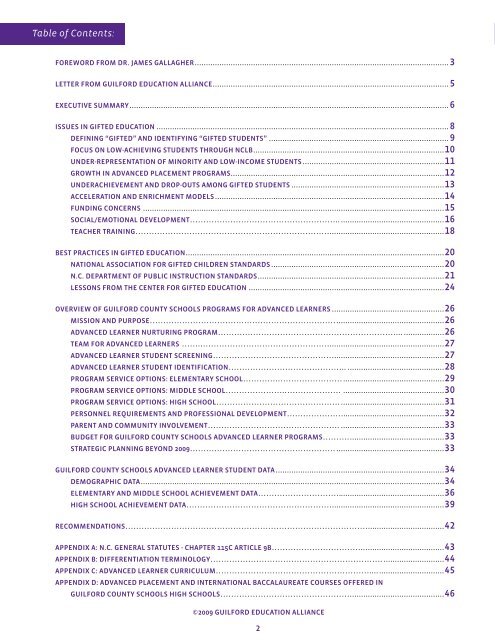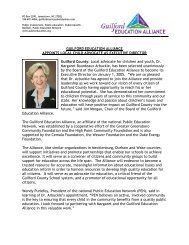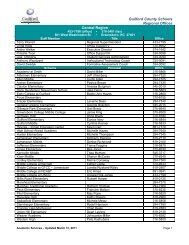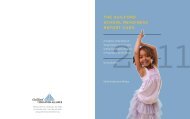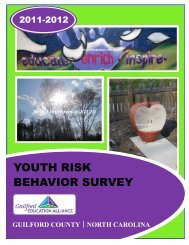2009 Advancing Excellence: A Report on Gifted Education - Guilford ...
2009 Advancing Excellence: A Report on Gifted Education - Guilford ...
2009 Advancing Excellence: A Report on Gifted Education - Guilford ...
Create successful ePaper yourself
Turn your PDF publications into a flip-book with our unique Google optimized e-Paper software.
Table of C<strong>on</strong>tents:<br />
Foreword from Dr. James Gallagher................................................................................................................. 3<br />
Letter from <strong>Guilford</strong> Educati<strong>on</strong> Alliance......................................................................................................... 5<br />
Executive Summary.............................................................................................................................................. 6<br />
Issues in <strong>Gifted</strong> Educati<strong>on</strong>................................................................................................................................... 8<br />
Defining “<strong>Gifted</strong>” and Identifying “<strong>Gifted</strong> Students”................................................................................. 9<br />
Focus <strong>on</strong> Low-Achieving Students through NCLB.....................................................................................10<br />
Under-Representati<strong>on</strong> of Minority and Low-Income Students...............................................................11<br />
Growth in Advanced Placement programs...............................................................................................12<br />
Underachievement and Drop-outs Am<strong>on</strong>g <strong>Gifted</strong> Students.....................................................................13<br />
Accelerati<strong>on</strong> and Enrichment Models......................................................................................................14<br />
Funding C<strong>on</strong>cerns.......................................................................................................................................15<br />
Social/Emoti<strong>on</strong>al Development……………………………………………….................................................16<br />
Teacher Training………………………………………………………………...................................................18<br />
Best Practices in <strong>Gifted</strong> Educati<strong>on</strong>...................................................................................................................20<br />
Nati<strong>on</strong>al Associati<strong>on</strong> for <strong>Gifted</strong> Children Standards.............................................................................20<br />
N.C. Department of Public Instructi<strong>on</strong> Standards...................................................................................21<br />
Less<strong>on</strong>s from The Center for <strong>Gifted</strong> Educati<strong>on</strong>........................................................................................24<br />
Overview of <strong>Guilford</strong> County Schools Programs for Advanced Learners...................................................26<br />
Missi<strong>on</strong> and Purpose……………………………………………………………................................................26<br />
Advanced learner Nurturing Program…………………………………………………………......................26<br />
Team for Advanced Learners …….…………………………………………...................................................27<br />
Advanced Learner Student Screening……………………………………….................................................27<br />
Advanced Learner Student Identificati<strong>on</strong>……………………………………..............................................28<br />
Program Service Opti<strong>on</strong>s: Elementary School………….…………………….............................................29<br />
Program Service Opti<strong>on</strong>s: Middle School………………….…………………..............................................30<br />
Program Service Opti<strong>on</strong>s: High School………………………………………................................................31<br />
Pers<strong>on</strong>nel Requirements and Professi<strong>on</strong>al Development………………….............................................32<br />
Parent and Community Involvement…………………………………………................................................33<br />
Budget for <strong>Guilford</strong> County Schools Advanced Learner Programs………............................................33<br />
Strategic Planning Bey<strong>on</strong>d <str<strong>on</strong>g>2009</str<strong>on</strong>g>………………………………………………................................................33<br />
<strong>Guilford</strong> County Schools Advanced Learner Student Data...........................................................................34<br />
Demographic Data.......................................................................................................................................34<br />
Elementary and Middle School Achievement Data…………………………...............................................36<br />
High School Achievement Data………………………………………………..................................................39<br />
Recommendati<strong>on</strong>s………………………………………………………………………………..................................42<br />
Appendix A: N.C. General Statutes - Chapter 115C Article 9B…………………………….....................................43<br />
Appendix B: Differentiati<strong>on</strong> Terminology……………………………………………………….............................44<br />
Appendix C: Advanced Learner Curriculum…………………………………………………..................................45<br />
Appendix D: Advanced Placement and Internati<strong>on</strong>al Baccalaureate Courses Offered in<br />
<strong>Guilford</strong> County Schools High Schools…………………………………………..........................................46<br />
©<str<strong>on</strong>g>2009</str<strong>on</strong>g> <strong>Guilford</strong> Educati<strong>on</strong> Alliance<br />
Foreword:<br />
It is my pleasure and privilege to provide a<br />
foreword to this report, which provides a fine<br />
summary of where educati<strong>on</strong> of advanced<br />
learners stands today and what can be d<strong>on</strong>e<br />
about it in <strong>Guilford</strong> County. It’s true that<br />
the federal No Child Left Behind legislati<strong>on</strong><br />
has been the predominant federal educati<strong>on</strong><br />
initiative in the last five years. That law proposes<br />
to measure whether schools are doing their<br />
best to bring students up to basic standards<br />
of learning. What is wr<strong>on</strong>g with that, you may<br />
ask? Nothing at all—but it <strong>on</strong>ly touches <strong>on</strong>e of<br />
America’s two great educati<strong>on</strong>al goals, equity,<br />
while ignoring the other, excellence.<br />
We should not believe that we must choose<br />
between equity and excellence, when it is critical<br />
that we address them both in American public<br />
schools. We have in this great heterogeneous<br />
culture advanced students of every ethnic and<br />
racial group; students of breath-taking abilities<br />
and talents that must be nurtured and never<br />
taken for granted. Malcolm Gladwell, in his new<br />
book The Outliers, describes how talent needs to<br />
be nurtured; to be eminent in the arts or sciences<br />
means 10,000 hours of dedicated study and<br />
guided practice, no matter your basic ability.<br />
China and India, our ec<strong>on</strong>omic challengers in<br />
the 21 st century, have learned that less<strong>on</strong> well.<br />
They are busily turning out ten times more<br />
engineers and scientists than we are. And what<br />
does that mean for our future and the future of<br />
our children and grandchildren? If you want a<br />
hair-raising portrait of just that c<strong>on</strong>sequence you<br />
can read Rising Above the Gathering Storm, a<br />
book put together for the Nati<strong>on</strong>al Academy of<br />
Sciences by a team of university presidents and<br />
American Nobel prize winners.<br />
False Less<strong>on</strong>s<br />
It is not helpful that many of our advanced<br />
learners have learned some false less<strong>on</strong>s from<br />
their school experience. Namely, they can<br />
c<strong>on</strong>clude that learning is easy and that even<br />
hard problems can be solved with just a little<br />
bit of extra effort and attenti<strong>on</strong>. I recall sitting<br />
in <strong>on</strong> a special class of middle school advanced<br />
learners in mathematics at the University of<br />
Illinois some years ago. Their brilliant<br />
instructor gave them an assignment over<br />
the weekend. On M<strong>on</strong>day the students<br />
were back puzzled because they couldn’t<br />
get the answer. The instructor said that<br />
he wasn’t surprised because few pers<strong>on</strong>s<br />
in human history had ever solved those<br />
problems. The students were furious, but they<br />
learned a great less<strong>on</strong> that day: some problems<br />
require a great amount of effort and attenti<strong>on</strong>,<br />
and even then may resist a soluti<strong>on</strong>.<br />
A recent study tried to understand why Asian<br />
students seem to do better in advanced tests<br />
than do American students. They found the<br />
Asian students willing to spend more time <strong>on</strong><br />
the difficult problems before giving up. Why<br />
<strong>on</strong>ly in American athletics do we have signs<br />
that say, “110% effort required,” or “When the<br />
going gets tough, the tough get going”? We want<br />
our students to learn how to persist <strong>on</strong> the<br />
difficult problems because we certainly have<br />
a great collecti<strong>on</strong> of them waiting for the next<br />
generati<strong>on</strong> of graduates.<br />
Curriculum and Accelerati<strong>on</strong><br />
In the educati<strong>on</strong> of advanced learners we are<br />
sometimes c<strong>on</strong>fr<strong>on</strong>ted with a false choice between<br />
differentiated curriculum or accelerati<strong>on</strong>. It is<br />
clear, as this report presents, that we should be<br />
doing both. We should enrich the curriculum<br />
because these students are ready to be challenged<br />
to think about c<strong>on</strong>cepts well bey<strong>on</strong>d their<br />
life age in programs such as the Internati<strong>on</strong>al<br />
Baccalaureate program or in the new curricula<br />
publicati<strong>on</strong>s from The Center for <strong>Gifted</strong><br />
Educati<strong>on</strong> at The College of William & Mary. Nor<br />
should we wait until middle school to provide<br />
special enriched experiences for advanced<br />
students; the primary grades should provide such<br />
experiences. Indeed it is when we provide these<br />
early experiences that we discover some hidden<br />
talent from students who are not excited by<br />
school or interested in normal school activities.<br />
2 3


